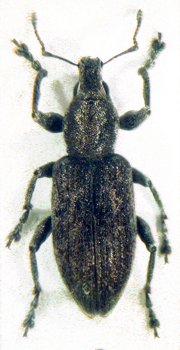Pests
Tanymecus palliatus F. - Beet leaf weevil.
Systematic position.
Class Insecta, order Coleoptera, family Curculionidae, genus Tanymecus. Closely related to T. dilaticollis.Biological group.
Pest of beet, sunflower, soybean, and perennial legumes and grasses.Morphology and biology.
Body length, 7.5-10 mm. Dorsum with vestiture of brownish hairs and small grayish-silvery scales. Lateral and ventral sides of the body are lighter. Rostrum flat, short, quadrangular. Eyes oval, slightly convex. Pronotum as wide as long, widest at distal 1/3. Postocular lobes of prothorax has a row of long rigid hairs. Wings are reduced. One generation develops about 2 years. Spring activity of the beetles starts when average temperatures at a soil depth of 20 cm are 4-4.8°C. Mating continues from the end of April to the beginning of May. Mass oviposition continues from the second half of May till the middle of June. Females lay eggs on surface of the soil. Fertility is about 400 eggs on average. Beetles begin dying at the end of July. Eggs develop in about 16 days at a temperature of 23°C. Larva has 10 instars, and develops in about 13-14 months. It lives in the soil and uses roots of perennial and biennial weeds for food. Adults and larvae hibernate together at the same time. Larvae hibernate at a depth up to 100 cm, and adults at a depth of 15-50 cm. Pupation occurs in soil chambers in July-August. The pupa is light-colored, 8-12 mm in length, and develops in 20 to 25 days.Distribution.
T. palliatus inhabits Europe and Anterior Asia. In the European part of the former USSR it is widely distributed from the southern state border to a latitude of 60 degrees N, in Siberia from the West to Altai region, extending into the Artic Circle along the Yenisei River valley.Ecology.
Typical polyphage, feeding on various species of Asteraceae, Fabaceae, Chenopodiaceae, Amaranthaceae, Polygonaceae, Convolvulaceae, Brassicaceae, Urticaceae, but prefer plants from the genera Cirsium, Carduus, Convolvulus. Beetles select oviposition localities where Bindweed and Sow-Thistle are abundant. The largest fertility of females is on Bindweed. Rooks, Sparrows, Starlings, and the predatory beetles Pterostichus sp. and Hister bipustulatus feed on Weevil adults.Economic significance.
The species is more numerous in the Central and Western regions of the European part of the former USSR, and is harmful in the adult stage. Injury from this pest is usually not large. Beetles gnaw shoots, cotyledons, and young first leafs. Pest harmfulness decreases after the appearance of the second pair of true leaves. Main control measures include elimination of weeds in fields and early autumn plowing.Reference citations:
Dieckmann L. 1983. Contributions to the insect fauna of the GDR: Coleoptera - Curculionidae (Tanymecinae, Leptopiinae, Cleoninae, Tanyrhynchinae, Cossoninae, Raymondionyminae, Bagoinae, Tanysphyrinae). Beitrage Entomolgie, Berlin, 33(2) 257-381. (In German)Freude H., Harde K.W., Lohse G.A. 1981. Beetles of Middle Europe. Krefeld: Goecke & Evers. 310 pp. (In German)
Kryzhanovskii O.L., ed. 1974. The pest insects and ticks of agricultural plants. Leningrad: Nauka. V.2: 335. (In Russian)
Minoranskii V.A. 1976. Harmful insects in the beet fields. Rostov: Rostovskii University. 112 pp. (In Russian)
Petrukha O.O., Butovskij A.P. 1947. Beet leaf weevil. Moscow: Pischepromizdat. 68 pp. (In Russian)
Shchegolev V.N., ed. 1955. Agricultural Entomology. Leningrad & Moscow: Gos. Izd. Selskokhoz. Lit. 616 pp. (In Russian)
Zverezomb-Zubovskii E.V. 1956. Pests of sugar-beet. Kiev: UkrSSR. 276 pp. (In Russian)


